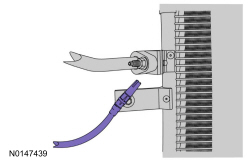
023-00186 or equivalent

339-00002 or equivalent
SECTION 412-00: Climate Control System — General Information and Diagnostics
| 2014 Mustang Workshop Manual
|
GENERAL PROCEDURES
| Procedure revision date: 01/07/2013
|
 | Infrared Refrigerant Leak Detector (SAE J-2791 Compliant)
023-00186 or equivalent |
 | Dual Mode Refrigerant Gas and UV Dye Leak Detector (SAE J-2791 Compliant)
339-00002 or equivalent |
NOTE: Good ventilation is necessary in the area where electronic A/C leak testing is to be carried out. If the surrounding air is contaminated with refrigerant gas, the Heated Pentode Halogen Leak Detector will indicate this gas all the time. Odors from other chemicals such as antifreeze, diesel fuel, disc brake cleaner or other cleaning solvents can cause the same problem. Using a fan to ventilate the area to be tested before proceeding with the leak detection procedure is helpful in removing small traces of contamination from the air, but the fan should be turned off during actual testing.
NOTE: R-134a is heavier than air, and will tend to move downward from the source of the leak if present. It is possible that a leak may not be detected if the leak detector tip is held above the leaking fitting, line or component. Always be sure to thoroughly leak test below the fitting, line or component for the presence of R-134a as well as leak testing above and around.
NOTE: The system pressure should be between 413-551 kPa (60-80 psi) at 24°C (75°F) with the engine off and cool. The pressure reading may be higher if the engine is hot.
Leak test the refrigerant system using the Heated Pentode Halogen Leak Detector. Follow the instructions included with the Heated Pentode Halogen Leak Detector for handling and operation techniques.